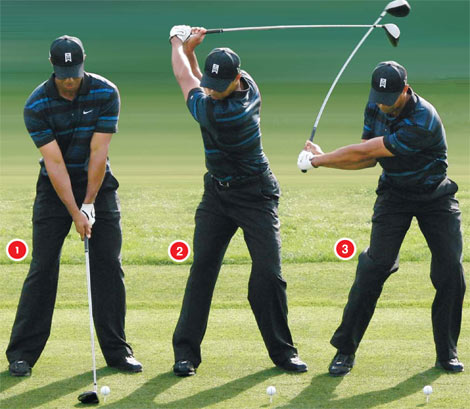The definition of dissociation is “the disconnection or separation of something from something else.” In golf, this is especially important in regards to pelvis and thorax (trunk) separation. The reasons are many and include everything from proper sequencing/ timing of the swing to production of club head speed and power. This is clearly observed in what the Titleist Performance Institute coined “The Kinematic Sequence.” A full review can be found —> HERE, but the basics are as follows:

1) There is an identical sequence of speed or energy generation for all great ball strikers. That sequence is: lower body first (red line on the graph above), trunk or torso second (green line), arms third (blue line), and the club last (yellow line). This sequence occurs during the downswing.
2) Each segment of the body builds on the previous segment, increasing speed up the chain. (Red is less than green, which is less than blue, which is less than yellow).
3) Each segment of the chain slows down once the next segment begins to accelerate. This is due to the distal segment pushing off the proximal segment. Imagine a child jumping off their dad’s shoulders in a swimming pool. As the child jumps, the force rapidly slows down the dad’s energy. This causes a sequential deceleration or stabilization of the segments.
4) Unorthodox styles may have no effect on your ability to generate a good kinematic sequence. In other words, Jim Furyk and Davis Love can have the same kinematic sequence.
As with any graph, the kinematic sequence graph can be confusing. But, the take home message is that all great ball strikers initiate the downswing with the lower body and pelvis first allowing the other body parts to accelerate and generate speed behind it in the proper sequence. If this does not happen, it can be due to a technique flaw which would require the guidance of a golf professional to improve swing mechanics. But, it also can be a physical limitation whereas the golfer is unable to dissociate the pelvis from the trunk because of flexibility or motor control deficits. If this is the case, it makes it very difficult to create a large turn in the back swing and/or begin the downswing with the lower body. Thus, the trunk comes with the pelvis causing improper sequencing and an unpredictable shot pattern (usually a block, slice, or duck hook). This is especially apparent in the over the top and early extension swing characteristics. A review and video of “over the top” can be found —> HERE and “early extension” —> HERE.
The only way to truly know if a physical limitation is contributing to the inability to dissociate during the golf swing is to assess the athlete by administering a physical screen. There are several tests that we use to qualitatively and quantitatively assess dissociation and they are as follows.
- The Pelvic Rotation Test which qualitatively tests the ability to dissociate the pelvic on a stable trunk (think downswing).
- View the test —> HERE.
- The Torso Rotation Test which qualitatively test the ability to dissociate the torso on a stable pelvis (think backswing).
- View the test —> HERE.
- The Seated Trunk Rotation Test which quantitatively tests if the golfer has enough mobility in the trunk (important in the backswing and downswing).
- View the test —> HERE.
- The Lower Quarter Rotation Test which quantitatively tests if the golfer has enough hip mobility (important in both backswing and downswing).
- View the test —> HERE.
Let’s identify dissociation in a real swing….
To help illustrate dissociation, let’s pretend that the golfer above is standing in the middle of a clock and his club in image #1 (address) is pointed towards 6 o’clock. Likewise, in this image his belt buckle (pelvis) and buttons of his shirt (trunk) are pointed towards 6 o’clock. Here there is no dissociation or separation. However, at the top of his backswing (image #2) his belt buckle is pointed towards 7 or 8 o’clock and his trunk is pointed at least to 9 o’clock. Now we are beginning to see some separation; in other words the pelvis and trunk aren’t pointing in the same direction. Furthermore, during the downswing (image #3) there is even more separation in which his belt buckle is pointing towards 5 o’clock, and his trunk is still back at around 8 o’clock. This increase in separation that begins in the down swing is called X-Factor Stretch and will be discussed later. Basically, this helps take the potential energy stored in the backswing and transfers it to kinetic energy and increase club head speed. If you want to read more about it please click —> HERE.
In summary, the ability to create separation and dissociate the hips from the torso is paramount in golf especially with the modern swing. In order for this to occur the golfer must have adequate neck, spine, shoulder, and hip mobility as well as proper coordination and motor control for the kinematic sequence to occur. Poor skill and swing mechanics can negate this from happening, but more often than not it is a physical limitation (flexibility or strength deficit) which can be assessed and corrected with specific exercises. If you are interested in learning if you have any physical limitation that is hindering your golf performance, find a Certified TPI Professional near you by clicking —> HERE.
